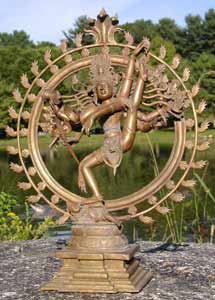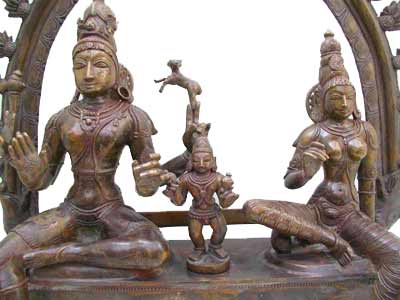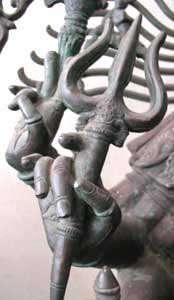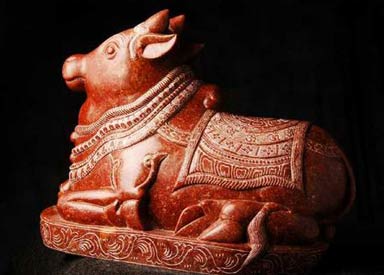The Cult of Shiva
Shaivism, or Saivism, is one of the most popular Hindu cults. It embraces many theological practices, although all agree on three principles: pati. or God; pasu, or individual soul; and pasa, or bonds that confine the soul to earthly existence. The aim of Shaivites is to rid their souls of bondage and achieve shivata, the "nature of Shiva". They achieve this through ascetic practices and penances, with an emphasis on yoga and renunciation. Many Shaivites become wandering sadhus, or hold men. Shiavites mark their foreheads with three horizontal marks representing the three aspects of Shiva.

Shiva wears a snake coiled around his upper arms and neck symbolizing the power he has over the most deadly of creatures. Snakes are also used to symbolize the Hindu dogma of reincarnation. Their natural process of molting or shedding their skin is symbolic of the human souls transmigration of bodies from one life to another.

Thiruvalangadu, north of Madras, is associated with the dance contest between Shiva and his consort in the form of Kali. According to legend, Shiva danced vigorously, and to subdue Kali, threw up his leg in the rhythm of the dance. Being a lady, Kali could not repeat this feat and stood dismayed. This dance and the subjugation of Kali, are described in the hymns of the female saint-poet Karaikkal Ammai.

Shiva's female consort and wife is Parvati; because of his generosity and reverence towards Parvati, Shiva is considered an ideal role model for a husband. The divine couple together with their sons - the six-headed Skanda and the elephant headed Shiva - reside on Mount Kailasa in the Himalayas.

He often holds a trident, which represents the Hindu trinity of Brahma, Shiva and Vishnu. It is also said to represent the threefold qualities of nature: creation, preservation and destruction, although preservation is usually attributed to Vishnu.
As the destroyer Shiva is dark and terrible, encircled with serpents and a crown of skulls.
Shiva wears sacred Rudraksha beads, perhaps a reference to his earlier name Rudra.
The crescent moon Shiva wears on his crown, besides being a symbol of Kama the goddess of nightly love, also represents the bull, Nandi, a fertility symbol.
Shiva holds a skull that represents samsara, the cycle of life, death and rebirth. Samsara is a central belief in Hinduism. Shiva himself also represents this complete cycle because he is Mahakala the Lord of Time, destroying and creating all things.

His guardian is Nandi (the white bull), whose statue can often be seen watching over the main shrine. The bull is said to embody sexual energy, fertility. Riding on its back, Shiva is in control of these impulses.
Shiva is represented in a variety of forms. One such form is as a lingam. The ovoid shape is a representation of the absolute perfection of Lord Shiva - if that which is beyond form had to be given form, the lingam would be the closest form to the mystical experience of the absolute perfection of Shiva.
Jai Shiv Ji
Search This Blog
Category List
Blog Archive
-
▼
2012
(26)
-
▼
March
(26)
- har har mahadev....
- A change is gonna come....
- Mahadeva temple in Tambdisurla, Goa, India.
- Shiva Parvati
- Temple of Pashupatinath in Kathmandu in Nepal
- 8 faces of Lord Shiva at the Pashupatinath Temple
- This huge Shivling which about 25ft tall
- Neelkanth Temple of Kumbhal Garh
- Harihar Ashram in Kankhal
- Lord Shiva in Coimbatore
- Kaleshwaram Shiva Temple
- shravan at kihim beach in Alibaug
- The Story of the Shiva Lingam
- The Cult of Shiva
- Rudraksha - Gift of Shiva
- Attributes of Lord Shiva
- Lord Shiva Information
- Shivling Images
- 1000 names of Shiva page 4
- 1000 names of Shiva page 3
- 1000 names of Shiva page 2
- 1000 names of Shiva page 1
- Story of Lord Shiva and his birth
- 108 names of Shiva
- Vaidyanath at Deogarh : Lord Shiva Jyotirlinga in ...
- About Lord Shiva
-
▼
March
(26)




